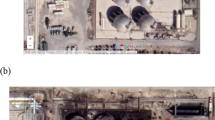Abstract
Chemical accidents generated during maintenance, repair, and normal operation, such as dispersion, fire, and explosions, can cause massive losses within and outside workplaces. Since a 2012 hydro fluorine leak in Gumi, South Korea, many studies have investigated mitigation systems for reducing accident impact. However, due to potential costs, and lack time and expertise, most companies have hesitated to install mitigation systems without accurate impact evaluations. Therefore, it is essential to analyze mitigation system efficacy under various possible accident scenarios. We considered a mitigation system incorporating a reserve vessel installed next to a storage vessel. When a leakage accident occurs, the chemical in the main vessel is transferred to the reserve vessel by a pump. Simulation results based on Torricellis’ theorem indicate that this mitigation system could significantly reduce leakage, and reduce leakage consequences in terms of maximum diffusion distance and hazardous gas concentrations based on consequence analysis.
Similar content being viewed by others
References
H. Meysami, T. Ebadi, H. Zohdirad and M. Minepur, J. Loss. Prevent. Proc., 26, 1407 (2013).
R. J. Parker, The Flixborough Disaster. Report of the Court of Inquiry, Her Majesty’s Stationary Office, London (1975).
M. J. Assael and K. E. Kakosimos, Fires, explosions, and toxic gas dispersions: effects calculation and risk analysis, CRC Press, Taylor and Francis Group, New York, U. S. A. (2010).
M. A. Rana, Y. Guo and M. S. Mannan, J. Loss. Prevent. Proc., 23, 77 (2010).
J. McQuaid and R. D. Fitzpatrick, North Western branch paper, Inst. Chem. E. (1981).
J. McQuaid and R. D. Fitzpatrick, J. Occup. Accid., 5, 121 (1983).
K. Moodie, Process Saf. Prog., 4, 234 (1985).
J. A. Suardin, R. Qi, B. R. Cormier, M. Rana and Y. Zhang, J. Loss. Prevent. Proc., 24, 63 (2011).
V. Busini and R. Rota, J. Loss. Prevent. Proc., 29, 13 (2014).
D. Liu and J. Wei, J. Loss. Prevent. Proc., 48, 14 (2017).
M. R. Swain, J. Shriber and M. N. Swain, Energy Fuels, 12, 1 (1998).
US Environment Protection Agency, Federal Emergency Management Agency, and US Department of Transportation, Technical guidance for hazard analysis - emergency planning for extremely hazardous substances, U. S. A. (1987).
Author information
Authors and Affiliations
Corresponding author
Rights and permissions
About this article
Cite this article
Lee, K.O., Park, J.Y. & Lee, C.J. Evaluation of a mitigation system for leakage accidents using mathematical modeling. Korean J. Chem. Eng. 35, 348–354 (2018). https://doi.org/10.1007/s11814-017-0288-6
Received:
Accepted:
Published:
Issue Date:
DOI: https://doi.org/10.1007/s11814-017-0288-6




